Sailing holidays are a unique experience. But what should you do if someone falls ill at sea and how can you provide effective first aid? Often a long way from port, it can be an overwhelming experience for an unprepared skipper. So, let's take a look at the more common illnesses and health problems that can occur at sea and a few general guidelines to follow before setting sail. Anything can happen on board a boat and you should always be prepared.
First aid principles on a boat
- When an acute problem occurs, always try to remain calm, and to calm down the others you are with.
- First, ensure that you are sailing safely — put someone in charge of the boat and its surroundings before going to treat the crew member who is unwell.
- If the condition requires medical attention, do not hesitate to end the voyage.
Which illnesses are commonly encountered on a boat?
It probably comes as no surprise that the most common illness on a boat is seasickness — up to 90 % of all boat passengers suffer from some form of seasickness (even if it's just for a few hours). Sailors are also commonly affected by heatstroke, sunstroke, asthma or other respiratory problems, cramps, hypothermia, allergies or upset stomachs.
Acute conditions at sea:
1. Seasickness
This is one of the things that worry novice sailors the most and it can really knock a person out. It's not just a matter of vomiting, seasickness can be pretty debilitating. As sailors have remarked: “you look forward to throwing up because at least then you won’t feel nauseous for a bit”. Interestingly, 5 % of the population is completely unaffected by seasickness and for the rest of us, the worst is usually over within 2–3 days.
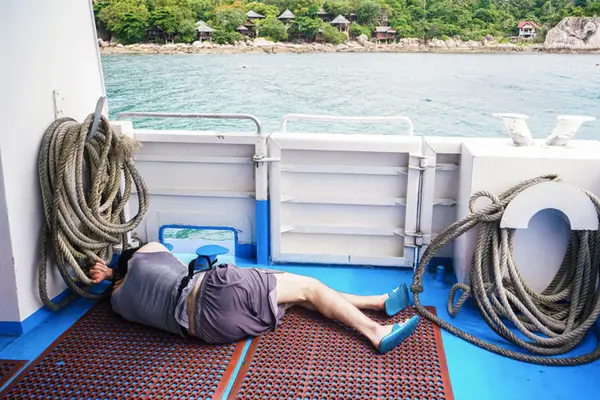 A man in the grips of seasickness
A man in the grips of seasickness - How do you relieve seasickness?
Put the afflicted person where the boat moves least, which is usually above the keel (behind the mast, in the centre of the ship). Or they can retreat to the salon or their cabin. It usually helps if they keep their eyes on a fixed point (e.g., the horizon).
Have them stand at the helm — they’ll be able to see the horizon, which will keep their mind occupied and help relieve the symptoms. Also to lighten their mood, keep them distracted and reassure them as much as possible. Although difficult, they should try to eat something light so as not to have an empty stomach. We deal with this illness in detail in our article How to cope with seasickness.
- What remedies are there for seasickness?
Medications for motion sickness are mostly freely available (e.g. Kinedryl tablets, Torecan suppositories, tablets or injections). A variety of travel gums are also popular. You can also try candied ginger or ginger tea. It is most effective to take your medications at least 1 to 2 hours before you set sail. Some medicines of this type also cause unwanted drowsiness, so it is best to check this out beforehand.
2. Heatstroke and sunstroke
In summer, overheating can occur very easily on board. So, what is the difference between heatstroke and sunstroke? Heatstroke is caused by a combination of high humidity and heat. It is the humidity that prevents the body from cooling itself down and can lead to a complete collapse. Sunstroke is caused by direct sunlight and there is a risk of brain swelling.
- First aid for heatstroke and sunstroke
First aid procedures are fairly straightforward — cooling. Move the person affected to the shade, undress them and apply cool wraps.
- What medications can be used to combat overheating?
It is also important to quickly replenish lost fluids, ions and minerals. For example, with a rehydration solution. You can buy them ready-made in a sachet which you then mix with water, or prepare one yourself according to the following recipe:
- 1 litre of water (preboiled, if possible)
- 1 teaspoon of salt
- 4 to 5 teaspoons of sugar
- (1 teaspoon of baking soda)
- The juice of 1 to 2 oranges or lemons (for potassium content)
The World Health Organization recommends the ratio per litre of boiled water:
Glucose 20 g
NaCl 3.5 g
KCl 1.5 g
Sodium bicarbonate or sodium citrate 2.5 g
3. Hypothermia
Falling into the cold springtime waters, or a lack of suitable clothing in inclement weather can result in dangerous cases of hypothermia. A person's whole metabolism, and respiratory and cardiac activity become impaired. Severe cases may lead to cerebral edema and death.
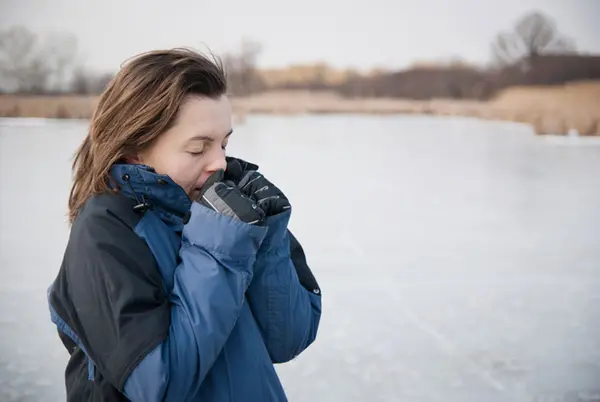 When hypothermia occurs, the most important thing is to prevent further heat loss
When hypothermia occurs, the most important thing is to prevent further heat loss- First aid for hypothermia
In cases of hypothermia, it is most important to prevent any further heat loss. Use a thermal blanket, a regular blanket, a hot-water bottle, or a warm wrap — a sheet covered with warm water (be careful not to scald them). You can also use the body heat of another crew member.
YACHTING.COM TIP: It is inadvisable to give the patient any alcohol! You may mistakenly believe that it helps to warm up the patient, but in reality ,it dilates the blood vessels and results in further cooling of the vital organs!
4. Intestinal complaints, stomach problems and vomiting
Stomach and intestinal problems are unavoidable on a boat. They can be caused by infection, contaminated water, food poisoning, irritation or as a result of seasickness.
- First aid for intestinal and stomach problems
It is advisable to use the rehydration solution mentioned earlier to replenish fluids, minerals and ions. And also a supportive diet.
- What medications can be used?
Endiaron, Ecefuryl (especially in tropical areas where traditional medicines do not work). Absorbents (such as charcoal) can also help. Reasec can be used, but because of the way it works, it is not advised to treat acute problems in the long term. For more serious conditions, an infusion may be necessary.
5. Asthma and respiratory problems
Asthma can be brought on by psychological stress that can easily occur on a yacht. What does an asthma attack look like? The sufferer may not be able to breathe easily, resulting in a perceived feeling of suffocation. An acute attack may result in hyperventilation. Asthmatics are usually aware of their condition and will normally have medication at hand.
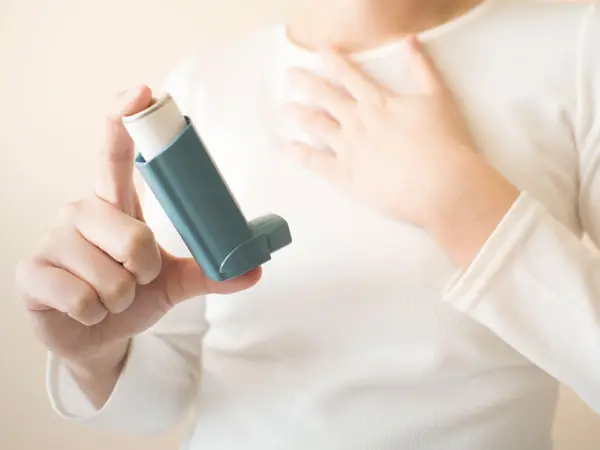 Asthma inhaler
Asthma inhaler - How can we effectively aid someone having an asthma attack?
Reassure them and help them get into a sitting position with their elbows on their knees and head in their hands. This position helps the patient to relax and allows the abdominal and intercostal muscles to work more easily, aiding respiration.
- What medication can be used?
Most asthmatics carry their medication with them, but if an unexpected asthma attack occurs, it is a good idea to keep an inhaler in the onboard first aid kit.
YACHTING.COM TIP: Despite all safety precautions, accidents can easily happen on a boat. Be prepared for this by checking out our tips on how to effectively deal with accidents and injuries on a boat.
6. Allergies and allergic reactions
Allergic reactions can be caused by many things — food, insect bites, stings, medications, pollen, mould and chemicals. Symptoms include itching, rash, swelling and breathing difficulties. A strong allergic reaction can result in anaphylactic shock.
- First aid for allergies
Try to find out what caused the reaction and prevent further contact with the allergen. The problem may be a delayed allergic reaction; these can occur up to 32 hours after exposure to the allergen. Try to cool any swelling, including the tongue.
- What medications can be used?
Antihistamines (Zyrtec, Zodac, Dithiaden, or Fenistil ointment). Those with severe allergies will usually have an EpiPen (epinephrine autoinjector) with them. In the case of anaphylactic shock, it will be necessary to put the patient into the shock position (passive leg raise), call for medical assistance immediately, and be prepared to perform CPR (cardiopulmonary resuscitation) on them.
Chronic and long-term diseases way worsen at sea
Diabetes and hypoglycaemia (low blood sugar)
Diabetics can suffer from hypoglycaemia, even if they normally have their condition under control. This may be the result of a change in routine and eating patterns on the boat, leading to sugar being consumed more quickly. Increased physical activity is also a risk.
 Sugar is a quick fix for hypoglycaemia
Sugar is a quick fix for hypoglycaemia Symptoms of hypoglycaemia vary. Among them are confusion, a state of seeming drunkenness, restlessness, sleepiness, and sometimes even aggression.
- First aid for hypoglycaemia
The general treatment is to give them sugar, but be careful that they don't choke on it which can happen during seizures. A more effective method it is to smear the inside of the mouth with jam or a sugar solution so that it is absorbed by the mucous membrane. Ideally, a diabetic will have a glucagon pen (the opposite of insulin: it is important not to inject insulin in this condition). The opposite is hyperglycaemia.
Epilepsy
Epilepsy is a chronic condition of the brain and can lead to epileptic seizures. Seizures may manifest differently, for example, localised tics only, twitching, pins and needles, or temporary short-sightedness. A more serious seizure may involve unconsciousness, convulsions and twitching.
- First aid for epilepsy
In the event of convulsions, physical injuries should be prevented. Remove any clothing which may result in the patient being hurt. The patient should be placed in the recovery position.
The seizure will usually run its course without any need for further intervention (symptoms of epileptic seizures such as convulsions and shallow breathing actually reduce epileptic activity). There is no need to medicate following a seizure. However, after the initial seizure, a doctor's examination is necessary.
Cardiac problems and heart disease
These include various diseases and conditions — heart attack, stroke and aggravation of chronic problems. Chest pain around the sternum is the most common symptom, but pain in other areas, palpitations and shortness of breath may also occur.
- First aid for cardiac problems
Calm the patient and put them into a sitting position. If the patient already takes medication for the condition, administer the usual dose. Call for help and be ready to perform CPR (cardiopulmonary resuscitation).
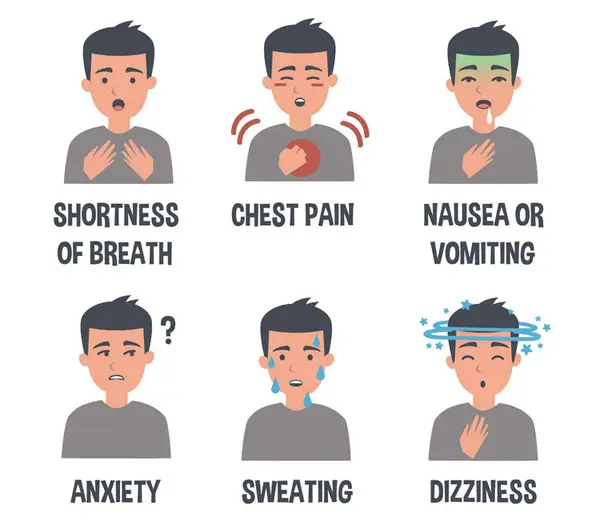 Symptoms of a heart attack
Symptoms of a heart attack Regular illnesses and pains (toothache, colds, inflammation and infections)
More often than not, even common, everyday illnesses and pains end up taking us by surprise. When sailing, these can seem more unbearable, often because the solution to the problem is less readily available (for example cooling down, the opportunity to rest well, etc.) and unpleasant in combination with the waves and rocking of the boat.
It is advisable to prepare a first aid kit for these complaints, including analgesics, broad-spectrum antibiotics (if possible), cough drops, etc.
A bit of advice before setting sail...
These tips will equip you to deal with illness and administer first aid at sea but before you set sail, you should know:
- The general health of the whole crew and the medications they take. Make sure the entire crew is aware of these in case there are problems.
- Always take a well-equipped first aid kit on board, including medications for common illnesses (e.g., ear infections, colds …).
- Inform the crew where the first aid kit and medication are stored, e.g., with the rescue equipment.
- Take a first aid course — help may not be available and is often far away.
- Consider which vaccinations you need before travelling (e.g., tetanus, hepatitis, or other recommended vaccinations for exotic destinations).
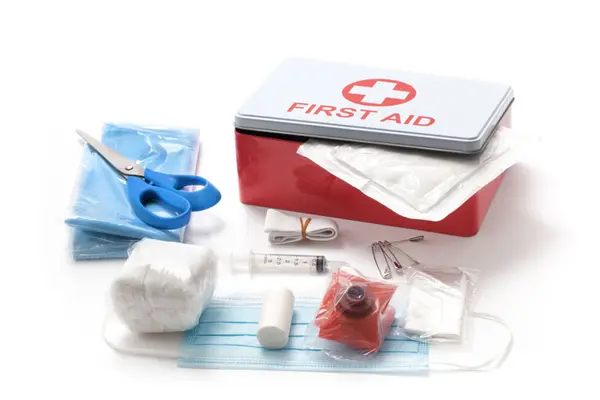 First aid kit
First aid kit - Special Offers on Sailboats°
- Luxury Sailboats°
- Affordable Sailboat Charters°
